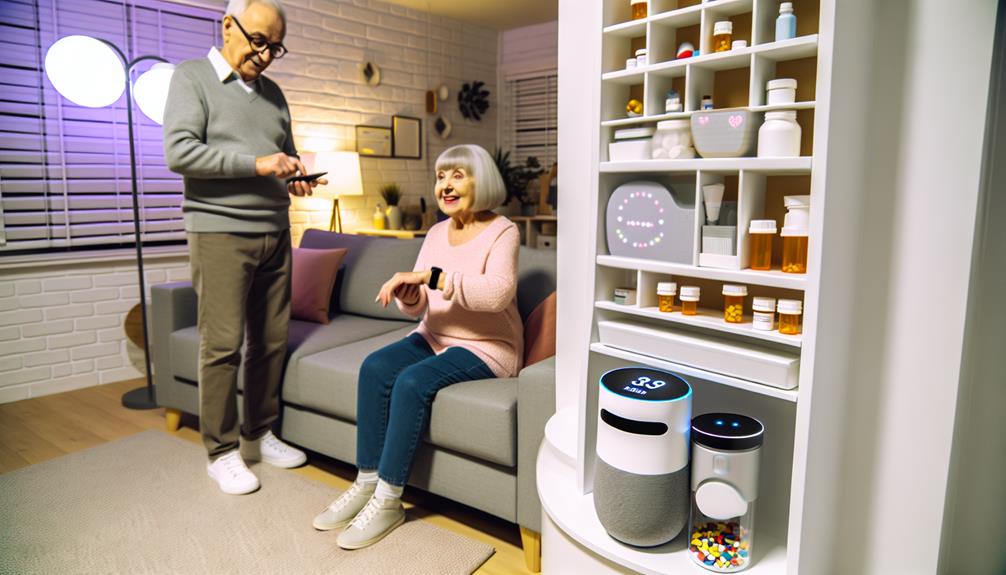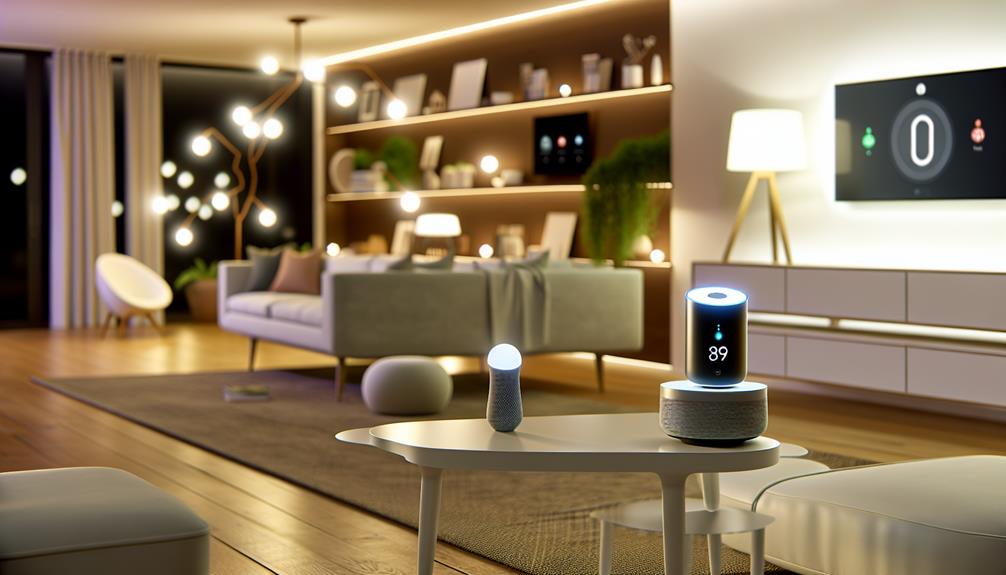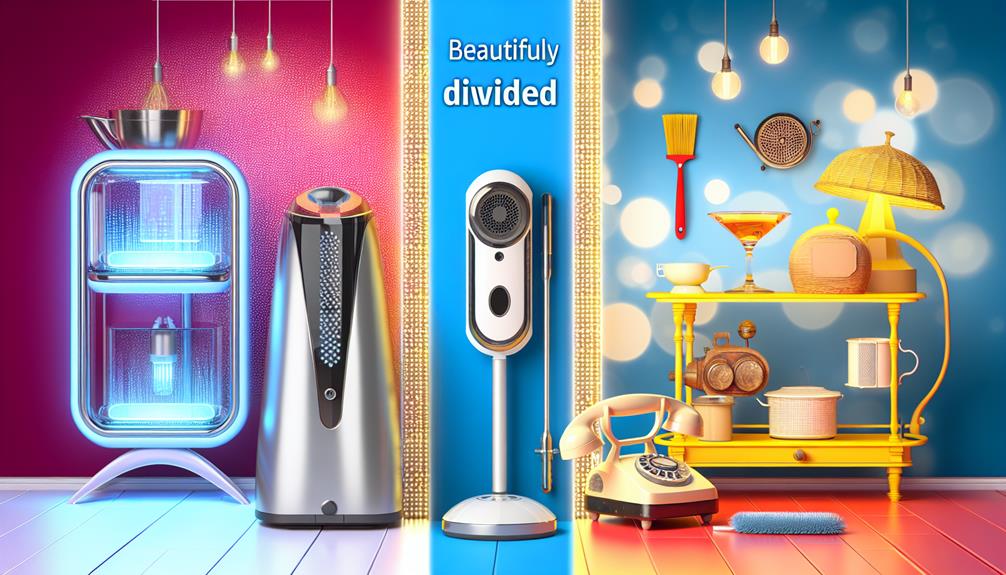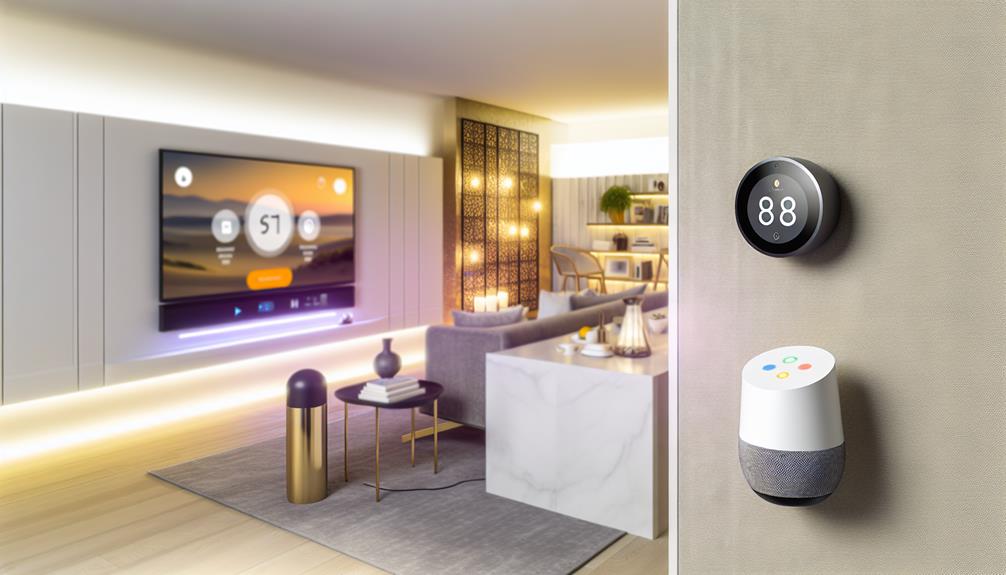Innovative Smart Gadgets Enhancing Elderly Care Today
The integration of innovative smart gadgets in elderly care is reshaping how we approach the needs of aging populations. From voice-activated assistants that streamline daily tasks to advanced health monitoring wearables that provide real-time insights, these technologies are not merely conveniences but essential tools that enhance safety and promote independence. As we explore the multifaceted benefits of these devices, it becomes clear that their impact extends beyond immediate functionality, potentially redefining the caregiver-senior relationship. However, the future of elderly care technology raises critical questions about adoption, accessibility, and ethical considerations.
Key takeaways
- Voice-activated assistants simplify daily tasks and promote social engagement, reducing loneliness for older adults living independently.
- Health monitoring wearables provide continuous tracking of vital signs and detect falls, ensuring timely interventions and enhancing safety.
- Smart lighting solutions with adaptive brightness and motion sensors improve visibility and reduce fall risks during nighttime activities.
- Medication adherence solutions, such as automated dispensers and reminder apps, help seniors manage their medications effectively and maintain health.
- Remote monitoring capabilities allow caregivers to track medication adherence and receive real-time alerts, ensuring better support for elderly individuals.
Overview of Smart Home Devices
How can smart home devices enhance the quality of life for the elderly? The integration of smart home technology offers a transformative approach to daily living, particularly for older adults.
By leveraging smart home integration, devices such as voice-activated assistants, automated lighting, and smart thermostats create a user experience tailored to the needs of the elderly. These tools not only simplify tasks but also promote safety and independence.
For instance, smart home sensors can detect falls or unusual movements, alerting caregivers or family members in real-time. Similarly, automated reminders for medication schedules can alleviate the stress of self-management, allowing seniors to focus on their well-being.
Additionally, smart home devices enhance connectivity, enabling the elderly to maintain social interactions through video calls and messaging apps, thereby fostering a sense of belonging.
As we explore the domain of smart home devices, it becomes clear that their thoughtful integration can greatly improve the overall quality of life for the elderly.
Benefits of AI in Elderly Care
Numerous benefits arise from the integration of artificial intelligence (AI) in elderly care, greatly enhancing the quality of life for seniors. AI companionship offers emotional support, reducing feelings of loneliness and fostering a sense of belonging.
Through predictive analytics, caregivers can anticipate health issues before they escalate, enabling timely interventions and personalized care tailored to individual needs. AI-powered systems facilitate emergency response, ensuring seniors receive immediate assistance during critical situations.
Additionally, cognitive assistance tools help maintain mental acuity, engaging users in stimulating activities that promote cognitive health. Social engagement is further enhanced through AI, connecting seniors with family and friends, thereby nurturing essential relationships.
Moreover, remote diagnostics streamline healthcare by allowing professionals to monitor patients without requiring frequent visits. This capability not only improves access to care but also enhances user privacy and data security, reassuring families about their loved ones' safety.
Ultimately, the application of AI in elderly care leads to tailored interventions that meet the unique challenges of aging, creating a supportive environment where seniors can thrive. Through these advancements, AI establishes a foundation for a healthier, more connected life for the elderly, ensuring they feel valued and cared for.
Voice-Activated Assistants
Voice-activated assistants are transforming the landscape of elderly care by providing a user-friendly interface that empowers seniors to interact with technology effortlessly.
These devices leverage advanced voice recognition technology, allowing users to issue voice commands for a variety of tasks, making technology more accessible to those who may struggle with traditional interfaces.
One of the most significant benefits of voice-activated assistants is their ability to provide smart reminders, helping seniors manage medications and appointments seamlessly.
Personalized assistance can enhance daily routines, ensuring that tasks are completed on time without overwhelming the user. Additionally, these assistants are equipped to send emergency alerts, offering peace of mind to both seniors and their families.
Voice-activated assistants also foster social engagement by enabling users to make phone calls or send messages simply by speaking.
This capability is essential for combating loneliness and promoting a sense of connection. Moreover, activity monitoring features can alert caregivers to any deviations from normal behavior, ensuring timely interventions when necessary.
Smart Lighting Solutions
Smart lighting solutions are becoming increasingly essential in elderly care, offering both safety and convenience to seniors in their living environments.
These advanced systems not only enhance the quality of life but also foster a sense of belonging and independence.
Key features of smart lighting include:
- Adaptive Brightness: Automatically adjusts the light intensity based on the time of day or specific needs, ensuring ideal visibility and comfort.
- Smart Ambiance: Creates a personalized environment that can be tailored to individual preferences, promoting relaxation or alertness as needed.
- Motion Sensors: Lights activate upon detecting movement, minimizing the risk of falls during nighttime excursions.
- Remote Control: Allows caregivers and family members to manage lighting settings from afar, providing peace of mind and enhancing safety.
Health Monitoring Wearables
Health monitoring wearables have emerged as essential tools in elderly care, providing features such as continuous heart rate tracking, which allows for real-time health assessments.
Moreover, advanced fall detection technology can alert caregivers promptly, enhancing safety and response times.
Likewise, medication adherence solutions integrated within these devices help guarantee that seniors follow their prescribed treatment regimens, promoting overall well-being.
Continuous Heart Rate Tracking
Continuous heart rate tracking through health monitoring wearables represents a significant advancement in elderly care technology. These devices empower caregivers and family members by providing vital insights into the health and well-being of seniors.
Real-time monitoring of heart rate can lead to early detection of potential health issues, enabling prompt intervention when necessary.
Key benefits of continuous heart rate tracking include:
- Early Detection: Identify irregular heartbeats or sudden changes in heart rate that may indicate a medical emergency.
- Customized Care: Tailor health strategies based on individual heart rate patterns, enhancing personalized care plans.
- Peace of Mind: Family members can stay informed about their loved ones' health, fostering a sense of security and connection.
- Data-Driven Decisions: Access to historical heart rate data allows healthcare providers to make informed decisions regarding treatment and lifestyle adjustments.
Incorporating these wearables into daily life not only enhances the quality of care but also promotes a sense of belonging for both seniors and their families.
Fall Detection Technology
As elderly individuals often face increased risks of falls, integrating fall detection technology into health monitoring wearables has become increasingly crucial. These devices utilize advanced sensor placement to accurately identify falls, enabling rapid emergency response. By leveraging accelerometers and gyroscopes, wearables can discern between regular movements and falls, thereby minimizing false alarms.
User acceptance is critical for the successful adoption of this technology. Devices must be comfortable, discreet, and easy to use to encourage elderly individuals to wear them consistently. Additionally, caregiver training is essential to guarantee that caregivers understand how to interpret alerts and respond appropriately, fostering a supportive environment for users.
Data privacy remains a significant concern in health monitoring technologies. Manufacturers must prioritize secure data handling to protect sensitive information, fostering trust among users and their families.
Effective system integration is also crucial, allowing fall detection technology to work in harmony with other health monitoring systems.
Medication Adherence Solutions
Medication adherence remains a significant challenge for many elderly individuals, often leading to adverse health outcomes and increased healthcare costs. Effective strategies incorporating technology can help bridge this gap. Here are four innovative solutions:
- Pill Reminders: Smart pill dispensers and wearable devices provide timely alerts, ensuring medications are taken as prescribed.
- Dosage Tracking: Advanced health monitoring wearables enable users to log their medication intake, facilitating accurate dosage tracking.
- Medication Apps: User-friendly applications enhance health literacy by providing clear information on prescriptions, while also allowing for easy communication with healthcare providers.
- Pharmacist Consultations: Integrating technology with enhanced pharmacist involvement can help address adherence challenges, offering personalized advice and support.
These solutions promote family involvement and encourage technology acceptance. By utilizing behavioral incentives, such as rewards for consistent adherence, elderly individuals can feel a sense of accomplishment, fostering a supportive community.
Prescription management tools streamline the process, making it easier for users to stay on track. Ultimately, these innovative smart gadgets not only enhance medication adherence but also contribute to the overall well-being of elderly individuals, fostering a sense of belonging and care.
Automated Medication Dispensers
Automated medication dispensers play an essential role in enhancing medication adherence among the elderly by ensuring timely and accurate dosing.
Designed with user-friendly features, these devices facilitate ease of use for seniors, reducing the risk of medication errors.
Additionally, remote monitoring capabilities allow caregivers and health professionals to track adherence and intervene when necessary, promoting better health outcomes.
Medication Adherence Improvement
Ensuring consistent medication adherence is essential for the health and well-being of elderly individuals, particularly those managing chronic conditions.
Automated medication dispensers have emerged as pivotal tools in enhancing compliance, addressing common barriers such as forgetfulness and confusion. These devices not only dispense the correct dosage but also integrate technology to remind users of their medication schedules.
Key features that contribute to medication adherence improvement include:
- Pill Reminders: Alerts that notify users when it's time to take their medication, reducing the likelihood of missed doses.
- Adherence Apps: Companion applications that track medication schedules and offer insights into adherence patterns, empowering both users and caregivers.
- User-Friendly Alerts: Visual and auditory signals that enhance awareness and prompt timely action.
- Remote Monitoring: Allowing caregivers to receive updates on medication adherence, fostering a sense of community and accountability.
User-Friendly Design Features
Creating an effective user experience is vital for the success of automated medication dispensers, especially for elderly users who may face various cognitive and physical challenges. These devices must prioritize user-friendly design features to guarantee seamless interaction and enhance medication adherence.
Intuitive interfaces play an important role in this regard. By utilizing large buttons, clear labeling, and visual cues, these dispensers simplify the process of managing medications. Users can easily navigate through the system, reducing confusion and empowering them to take control of their health.
In addition, auditory prompts can be integrated to provide reminders, catering to those with visual impairments.
Ergonomic designs are equally important for promoting ease of use. Devices should be lightweight and easy to handle, allowing elderly users to comfortably access their medications without straining.
Moreover, thoughtful placement of compartments can accommodate users with limited dexterity, making sure that they can retrieve their medications with minimal effort.
Remote Monitoring Capabilities
Remote monitoring capabilities greatly enhance the functionality of medication dispensers, enabling caregivers and health professionals to track adherence and medication management in real-time.
This innovation is particularly essential for elderly care, where medication compliance can considerably impact health outcomes.
Key features of automated medication dispensers with remote monitoring include:
- Telehealth Integration: Seamlessly connects with telehealth platforms, allowing healthcare providers to monitor patient adherence remotely.
- Real-Time Alerts: Sends notifications to caregivers if a dose is missed, ensuring timely intervention.
- Data Analytics: Provides insights on medication-taking patterns, facilitating personalized care plans and adjustments as needed.
- Emergency Response: Integrates with emergency systems to alert caregivers or medical personnel if irregularities in medication intake are detected.
Security Systems and Cameras
Safety is a paramount concern for elderly individuals living independently, making security systems and cameras an essential component of modern elderly care. With advancements in home security technology, these systems provide peace of mind to both seniors and their families.
Effective caregiver collaboration is key, as these systems can be integrated into a broader elderly care strategy, ensuring that caregivers are promptly alerted to any unusual activity or emergencies.
While implementing security measures, addressing privacy concerns is essential. Seniors deserve to feel secure without compromising their privacy, necessitating user education about data privacy and the proper use of cameras.
Technology accessibility plays a significant role in ensuring that elderly individuals can easily navigate these systems, promoting their independence.
Installation support is also important; professionals can facilitate the seamless integration of security systems into existing home environments. Monitoring alerts provide real-time updates, enhancing emergency response capabilities.
Ultimately, the thoughtful implementation of security systems not only enhances the safety of elderly individuals but also fosters a sense of belonging and community, reassuring families that their loved ones are protected.
Fall Detection Sensors
As technology continues to enhance the landscape of elderly care, fall detection sensors emerge as a vital tool in promoting the well-being of seniors living independently.
These innovative devices are designed to monitor indoor mobility and provide timely emergency response when needed. By integrating advanced sensors and algorithms, they can accurately detect falls and alert caregivers or emergency services, ensuring that seniors receive prompt assistance.
Key features of fall detection sensors include:
- Real-time Monitoring: Continuous tracking of movement patterns to identify potential falls.
- Automatic Alerts: Immediate notifications sent to designated contacts or emergency services upon detection of a fall.
- User-friendly Design: Simple installation and operation, ensuring accessibility for elderly users.
- Data Analytics: Insights derived from movement data can help caregivers tailor support for individual needs.
Remote Caregiver Communication
Effective communication between elderly individuals and their caregivers is essential for ensuring safety and well-being.
Video calling solutions, instant messaging apps, and wearable alert devices represent innovative tools that facilitate real-time interaction and support.
These technologies not only enhance connectivity but also empower seniors to maintain independence while providing caregivers with crucial oversight.
Video Calling Solutions
Video calling solutions have emerged as a critical component in the landscape of remote caregiver communication, facilitating real-time interactions between caregivers and elderly individuals.
These platforms not only guarantee that health and safety concerns are addressed but also provide a sense of connectedness that combats feelings of isolation.
Key benefits of video conferencing for elderly care include:
- Enhanced Communication: Immediate visual and auditory interaction fosters better understanding.
- Accessibility: Easy-to-use applications can be tailored to the needs of elderly users, promoting independence.
- Virtual Companionship: Regular check-ins create opportunities for socialization, reducing loneliness and enhancing emotional well-being.
- Monitoring Health: Caregivers can conduct routine assessments, assuring timely interventions when necessary.
Incorporating video calling solutions into elderly care not only strengthens the caregiver-patient relationship but also promotes a community-oriented approach, fostering a sense of belonging.
As technology continues to evolve, the importance of these virtual platforms will certainly increase, paving the way for more thorough and compassionate care for our elderly population.
Adopting video conferencing tools is a significant step toward creating a supportive and connected environment for seniors, making sure they feel valued and understood.
Instant Messaging Apps
A growing number of caregivers and elderly individuals are turning to instant messaging apps to enhance communication and streamline care coordination. These platforms facilitate quick, efficient exchanges, allowing caregivers to stay connected with their loved ones, share updates, and address concerns in real-time. With user-friendly interfaces, these applications are designed to accommodate the varying tech-savviness of elderly users, promoting inclusivity and engagement.
In evaluating available options, it is essential to contemplate features that prioritize instant messaging security while ensuring ease of use. The table below highlights some popular instant messaging apps suitable for elderly care:
| App Name | Key Features | Security Measures |
|---|---|---|
| Voice messages, group chats | End-to-end encryption | |
| Telegram | Multimedia sharing, channels | Two-step verification |
| Signal | Voice and video calls | Advanced encryption |
| Facebook Messenger | Integration with Facebook | Encryption in transit |
| Viber | Rich media sharing, stickers | End-to-end encryption |
Wearable Alert Devices
Wearable alert devices have emerged as an essential tool for enhancing remote caregiver communication in elderly care. These innovative gadgets provide a seamless connection between seniors and their caregivers, ensuring immediate support when needed. The integration of advanced technology in these devices has transformed the landscape of elderly care, particularly in emergency situations.
Key features of wearable alert devices include:
- Emergency Response Activation: Users can easily trigger an emergency response with a simple button press, ensuring swift assistance.
- Alert Notifications: Caregivers receive real-time notifications, allowing for prompt intervention and peace of mind.
- Location Tracking: Many devices offer GPS functionality, enabling caregivers to monitor the whereabouts of their loved ones.
- Health Monitoring: Continuous health metrics can alert caregivers of potential health issues, fostering proactive care measures.
As the elderly population continues to grow, these wearable alert devices play a significant role in promoting safety and independence.
They foster a sense of belonging by ensuring that seniors feel connected and cared for, even when family members are not physically present.
In this way, technology enhances the quality of life for both seniors and their caregivers.
Future Trends in Elderly Technology
As the demand for innovative solutions in elderly care continues to rise, the future of technology in this sector promises significant advancements. Remarkably, the integration of robotic companions is paving the way for enhanced emotional and social support for seniors. These intelligent devices not only assist with daily tasks but also provide companionship, thereby reducing feelings of isolation among the elderly.
Furthermore, telehealth services are transforming how healthcare is delivered, allowing seniors to access medical consultations from the comfort of their homes. This trend is particularly beneficial in ensuring that elderly individuals receive timely and efficient care, minimizing the need for travel and enhancing adherence to medical advice.
Additionally, advancements in artificial intelligence and machine learning will lead to more personalized care solutions, tailoring services to the unique needs of each individual.
As these technologies evolve, we can expect a more connected and thorough approach to elderly care, fostering a sense of community and belonging. Ultimately, the future of elderly technology is not only about improving health outcomes but also about enriching lives, ensuring that seniors remain engaged and valued members of society.
Frequently Asked Questions
How Can I Choose the Right Smart Gadget for My Elderly Loved One?
"Measure twice, cut once." To choose the right smart gadget for your elderly loved one, assess user preferences alongside device features, ensuring the technology aligns with their needs and enhances their daily living experience.
Are These Smart Devices Compatible With Existing Home Technology?
Compatibility of smart devices with existing home technology is essential. Ensuring smart home integration and device compatibility allows for seamless interaction, enhancing user experience while fostering a sense of belonging and security for elderly individuals.
What Is the Average Cost of Smart Gadgets for Elderly Care?
The average cost of smart gadgets for elderly care varies considerably, requiring careful cost comparison and budget considerations. Prices range from affordable monitoring devices to more advanced systems, emphasizing the importance of aligning choices with financial capabilities.
How Do I Ensure the Privacy of My Elderly Family Member?
Guarding the sanctuary of one's personal space is essential. Prioritize privacy considerations by implementing robust data security measures, such as encryption and access controls, while fostering open communication to guarantee your elderly family member's comfort and trust.
Can These Devices Be Used Without Internet Connectivity?
Many smart devices exhibit offline functionality; however, their effectiveness may be limited. Understanding each device's specifications is essential, as some capabilities depend on internet connectivity, which could restrict usage in certain environments or scenarios.



